Strategic Analysis and Recommendations for Marriott Hotel Business
VerifiedAdded on 2019/12/03
|29
|10255
|231
Report
AI Summary
This report provides a comprehensive analysis of Marriott's business strategy within the tourism and hospitality sector. It begins by defining corporate strategy and applying it to Marriott, evaluating its chosen strategies and offering critical insights. The report then explores relevant analytical models such as SWOT and PESTLE, applying them to Marriott's operations and evaluating its organizational strategies. It proposes recommendations for future strategic development, considering aspects like internationalization, portfolio management, and resource allocation. The impact of organizational culture on strategy development and implementation is also examined, along with an assessment of key external environmental factors affecting Marriott. The report concludes with an overview of the company's competitive advantages, challenges, and recommendations for continued growth and success in the global hospitality market.
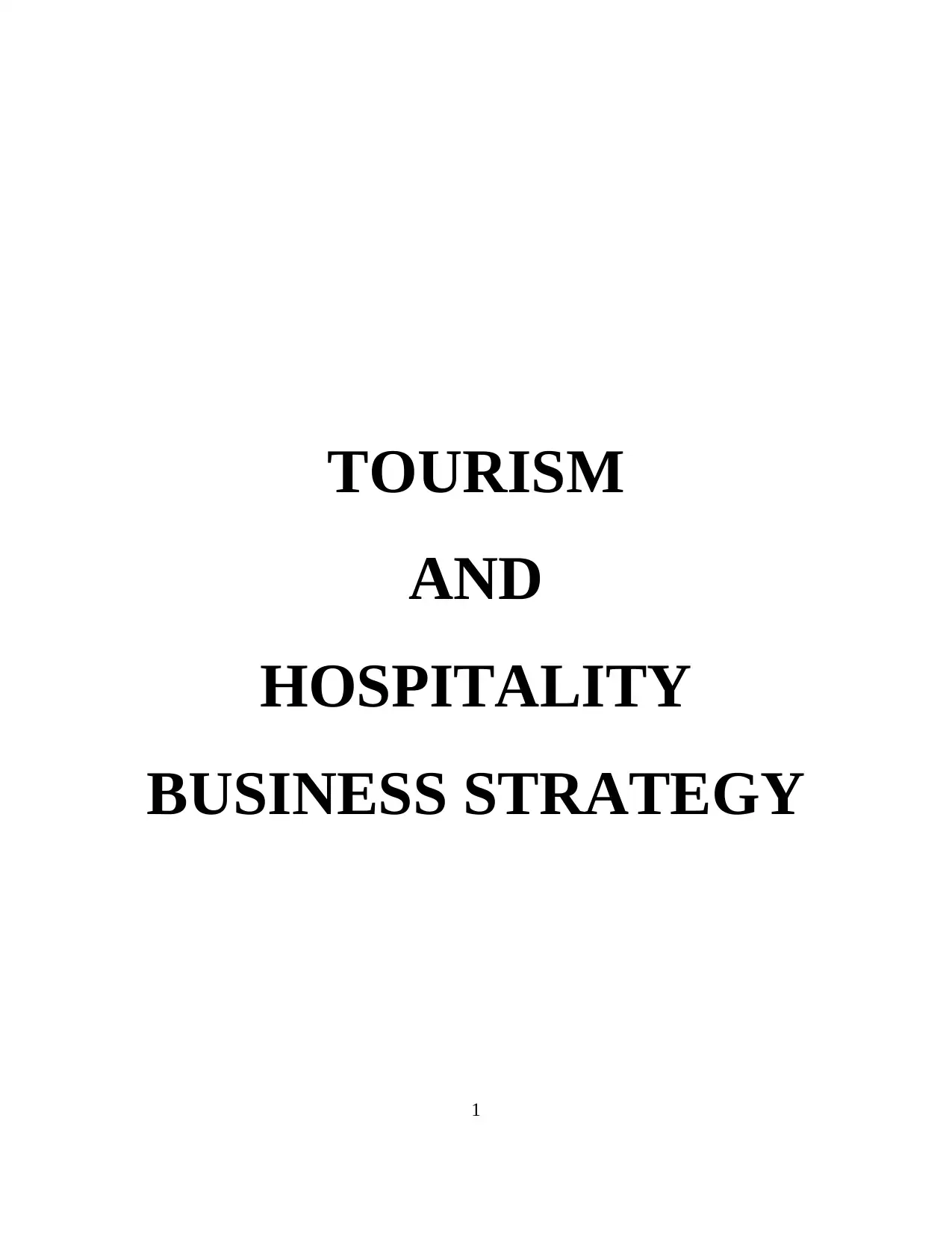
TOURISM
AND
HOSPITALITY
BUSINESS STRATEGY
1
AND
HOSPITALITY
BUSINESS STRATEGY
1
Paraphrase This Document
Need a fresh take? Get an instant paraphrase of this document with our AI Paraphraser
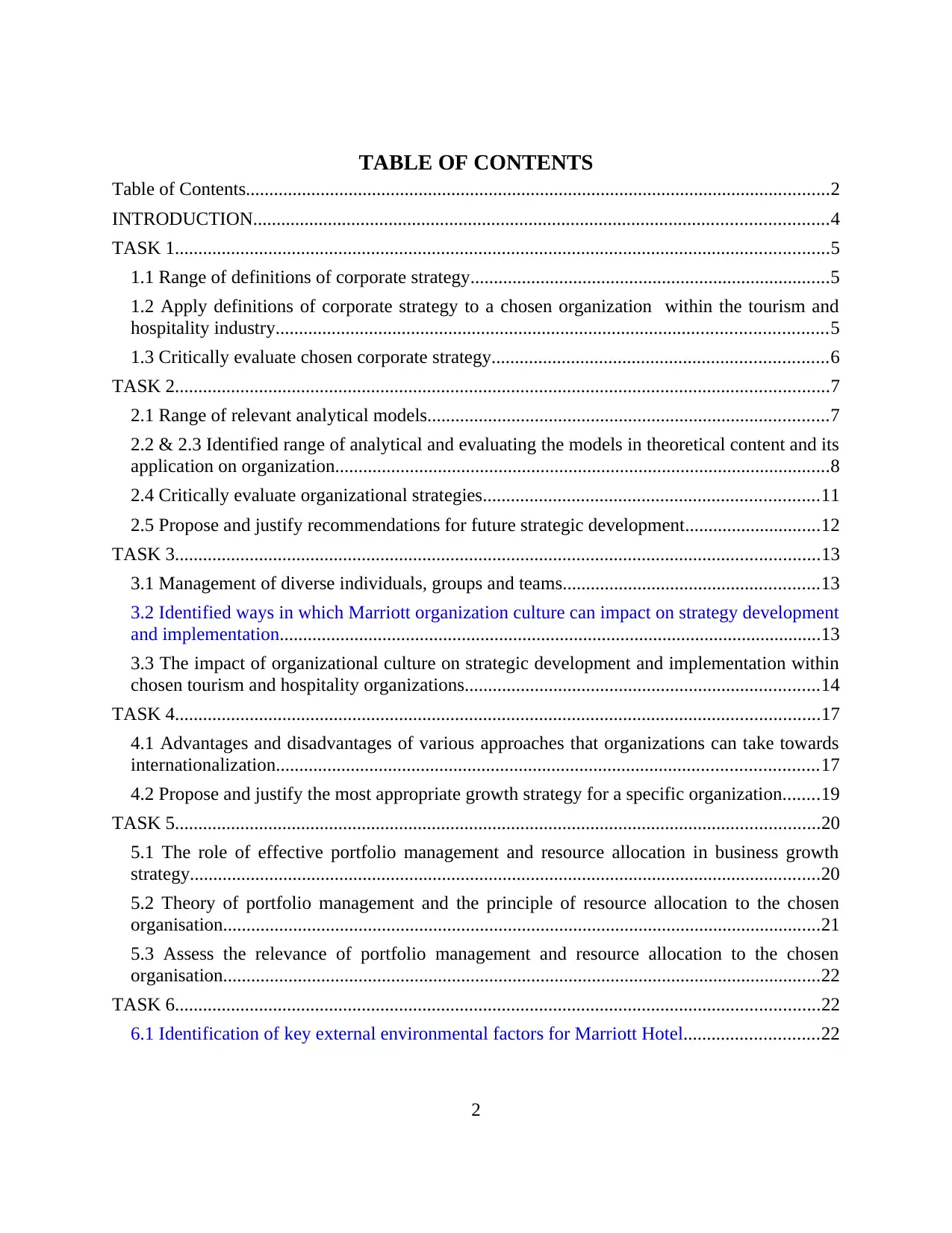
TABLE OF CONTENTS
Table of Contents.............................................................................................................................2
INTRODUCTION...........................................................................................................................4
TASK 1............................................................................................................................................5
1.1 Range of definitions of corporate strategy.............................................................................5
1.2 Apply definitions of corporate strategy to a chosen organization within the tourism and
hospitality industry......................................................................................................................5
1.3 Critically evaluate chosen corporate strategy........................................................................6
TASK 2............................................................................................................................................7
2.1 Range of relevant analytical models......................................................................................7
2.2 & 2.3 Identified range of analytical and evaluating the models in theoretical content and its
application on organization..........................................................................................................8
2.4 Critically evaluate organizational strategies........................................................................11
2.5 Propose and justify recommendations for future strategic development.............................12
TASK 3..........................................................................................................................................13
3.1 Management of diverse individuals, groups and teams.......................................................13
3.2 Identified ways in which Marriott organization culture can impact on strategy development
and implementation....................................................................................................................13
3.3 The impact of organizational culture on strategic development and implementation within
chosen tourism and hospitality organizations............................................................................14
TASK 4..........................................................................................................................................17
4.1 Advantages and disadvantages of various approaches that organizations can take towards
internationalization....................................................................................................................17
4.2 Propose and justify the most appropriate growth strategy for a specific organization........19
TASK 5..........................................................................................................................................20
5.1 The role of effective portfolio management and resource allocation in business growth
strategy.......................................................................................................................................20
5.2 Theory of portfolio management and the principle of resource allocation to the chosen
organisation................................................................................................................................21
5.3 Assess the relevance of portfolio management and resource allocation to the chosen
organisation................................................................................................................................22
TASK 6..........................................................................................................................................22
6.1 Identification of key external environmental factors for Marriott Hotel.............................22
2
Table of Contents.............................................................................................................................2
INTRODUCTION...........................................................................................................................4
TASK 1............................................................................................................................................5
1.1 Range of definitions of corporate strategy.............................................................................5
1.2 Apply definitions of corporate strategy to a chosen organization within the tourism and
hospitality industry......................................................................................................................5
1.3 Critically evaluate chosen corporate strategy........................................................................6
TASK 2............................................................................................................................................7
2.1 Range of relevant analytical models......................................................................................7
2.2 & 2.3 Identified range of analytical and evaluating the models in theoretical content and its
application on organization..........................................................................................................8
2.4 Critically evaluate organizational strategies........................................................................11
2.5 Propose and justify recommendations for future strategic development.............................12
TASK 3..........................................................................................................................................13
3.1 Management of diverse individuals, groups and teams.......................................................13
3.2 Identified ways in which Marriott organization culture can impact on strategy development
and implementation....................................................................................................................13
3.3 The impact of organizational culture on strategic development and implementation within
chosen tourism and hospitality organizations............................................................................14
TASK 4..........................................................................................................................................17
4.1 Advantages and disadvantages of various approaches that organizations can take towards
internationalization....................................................................................................................17
4.2 Propose and justify the most appropriate growth strategy for a specific organization........19
TASK 5..........................................................................................................................................20
5.1 The role of effective portfolio management and resource allocation in business growth
strategy.......................................................................................................................................20
5.2 Theory of portfolio management and the principle of resource allocation to the chosen
organisation................................................................................................................................21
5.3 Assess the relevance of portfolio management and resource allocation to the chosen
organisation................................................................................................................................22
TASK 6..........................................................................................................................................22
6.1 Identification of key external environmental factors for Marriott Hotel.............................22
2
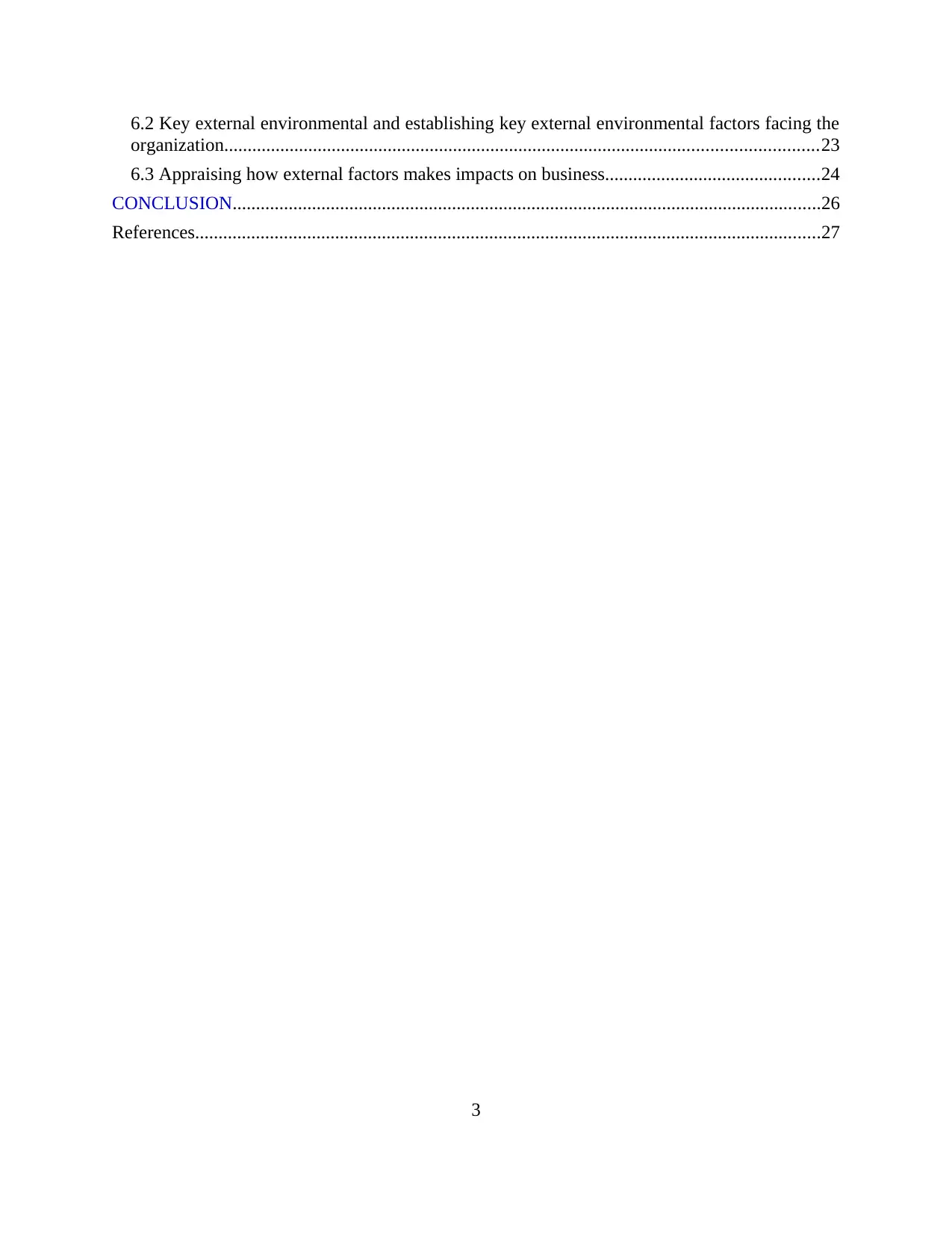
6.2 Key external environmental and establishing key external environmental factors facing the
organization...............................................................................................................................23
6.3 Appraising how external factors makes impacts on business..............................................24
CONCLUSION..............................................................................................................................26
References......................................................................................................................................27
3
organization...............................................................................................................................23
6.3 Appraising how external factors makes impacts on business..............................................24
CONCLUSION..............................................................................................................................26
References......................................................................................................................................27
3
⊘ This is a preview!⊘
Do you want full access?
Subscribe today to unlock all pages.

Trusted by 1+ million students worldwide
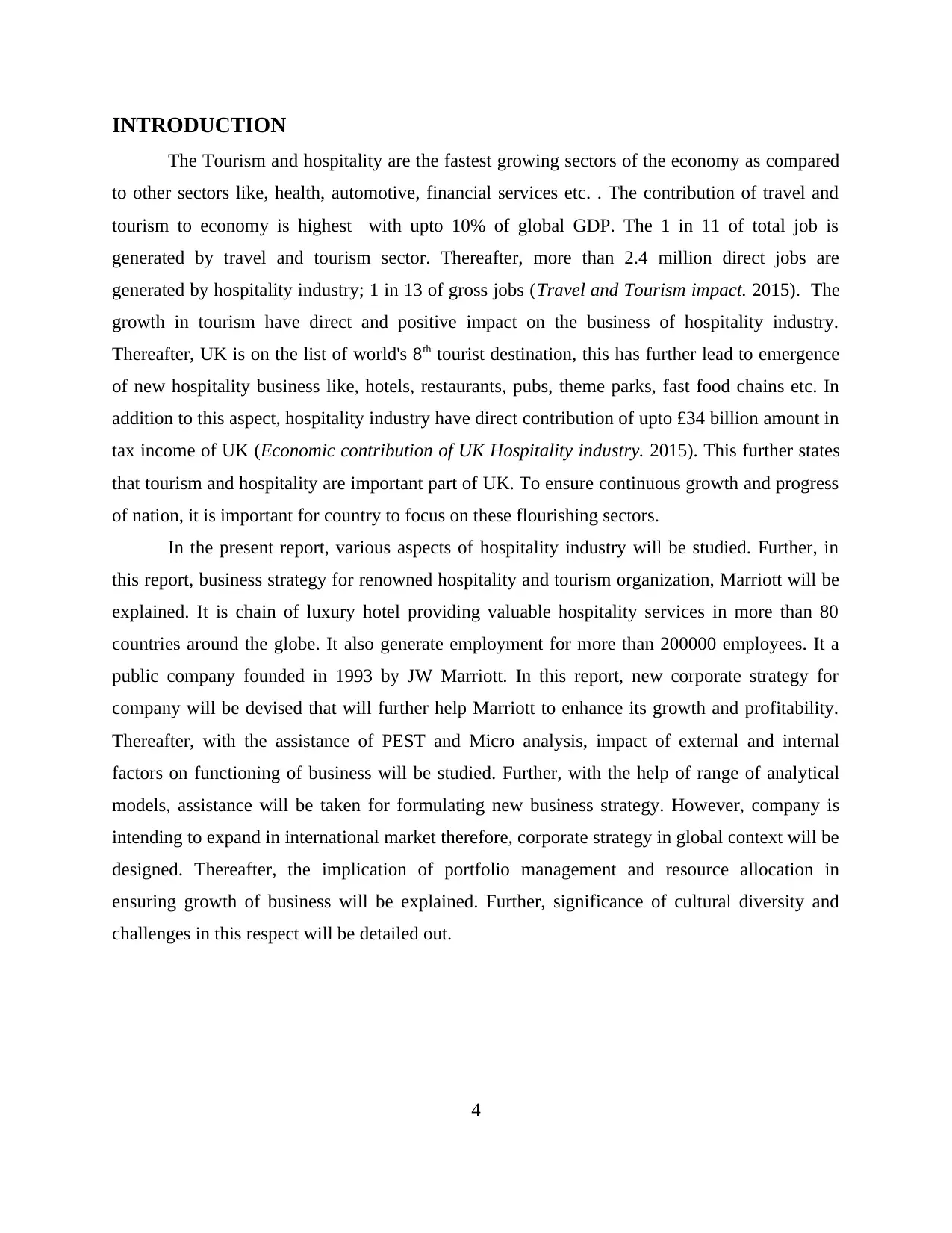
INTRODUCTION
The Tourism and hospitality are the fastest growing sectors of the economy as compared
to other sectors like, health, automotive, financial services etc. . The contribution of travel and
tourism to economy is highest with upto 10% of global GDP. The 1 in 11 of total job is
generated by travel and tourism sector. Thereafter, more than 2.4 million direct jobs are
generated by hospitality industry; 1 in 13 of gross jobs (Travel and Tourism impact. 2015). The
growth in tourism have direct and positive impact on the business of hospitality industry.
Thereafter, UK is on the list of world's 8th tourist destination, this has further lead to emergence
of new hospitality business like, hotels, restaurants, pubs, theme parks, fast food chains etc. In
addition to this aspect, hospitality industry have direct contribution of upto £34 billion amount in
tax income of UK (Economic contribution of UK Hospitality industry. 2015). This further states
that tourism and hospitality are important part of UK. To ensure continuous growth and progress
of nation, it is important for country to focus on these flourishing sectors.
In the present report, various aspects of hospitality industry will be studied. Further, in
this report, business strategy for renowned hospitality and tourism organization, Marriott will be
explained. It is chain of luxury hotel providing valuable hospitality services in more than 80
countries around the globe. It also generate employment for more than 200000 employees. It a
public company founded in 1993 by JW Marriott. In this report, new corporate strategy for
company will be devised that will further help Marriott to enhance its growth and profitability.
Thereafter, with the assistance of PEST and Micro analysis, impact of external and internal
factors on functioning of business will be studied. Further, with the help of range of analytical
models, assistance will be taken for formulating new business strategy. However, company is
intending to expand in international market therefore, corporate strategy in global context will be
designed. Thereafter, the implication of portfolio management and resource allocation in
ensuring growth of business will be explained. Further, significance of cultural diversity and
challenges in this respect will be detailed out.
4
The Tourism and hospitality are the fastest growing sectors of the economy as compared
to other sectors like, health, automotive, financial services etc. . The contribution of travel and
tourism to economy is highest with upto 10% of global GDP. The 1 in 11 of total job is
generated by travel and tourism sector. Thereafter, more than 2.4 million direct jobs are
generated by hospitality industry; 1 in 13 of gross jobs (Travel and Tourism impact. 2015). The
growth in tourism have direct and positive impact on the business of hospitality industry.
Thereafter, UK is on the list of world's 8th tourist destination, this has further lead to emergence
of new hospitality business like, hotels, restaurants, pubs, theme parks, fast food chains etc. In
addition to this aspect, hospitality industry have direct contribution of upto £34 billion amount in
tax income of UK (Economic contribution of UK Hospitality industry. 2015). This further states
that tourism and hospitality are important part of UK. To ensure continuous growth and progress
of nation, it is important for country to focus on these flourishing sectors.
In the present report, various aspects of hospitality industry will be studied. Further, in
this report, business strategy for renowned hospitality and tourism organization, Marriott will be
explained. It is chain of luxury hotel providing valuable hospitality services in more than 80
countries around the globe. It also generate employment for more than 200000 employees. It a
public company founded in 1993 by JW Marriott. In this report, new corporate strategy for
company will be devised that will further help Marriott to enhance its growth and profitability.
Thereafter, with the assistance of PEST and Micro analysis, impact of external and internal
factors on functioning of business will be studied. Further, with the help of range of analytical
models, assistance will be taken for formulating new business strategy. However, company is
intending to expand in international market therefore, corporate strategy in global context will be
designed. Thereafter, the implication of portfolio management and resource allocation in
ensuring growth of business will be explained. Further, significance of cultural diversity and
challenges in this respect will be detailed out.
4
Paraphrase This Document
Need a fresh take? Get an instant paraphrase of this document with our AI Paraphraser
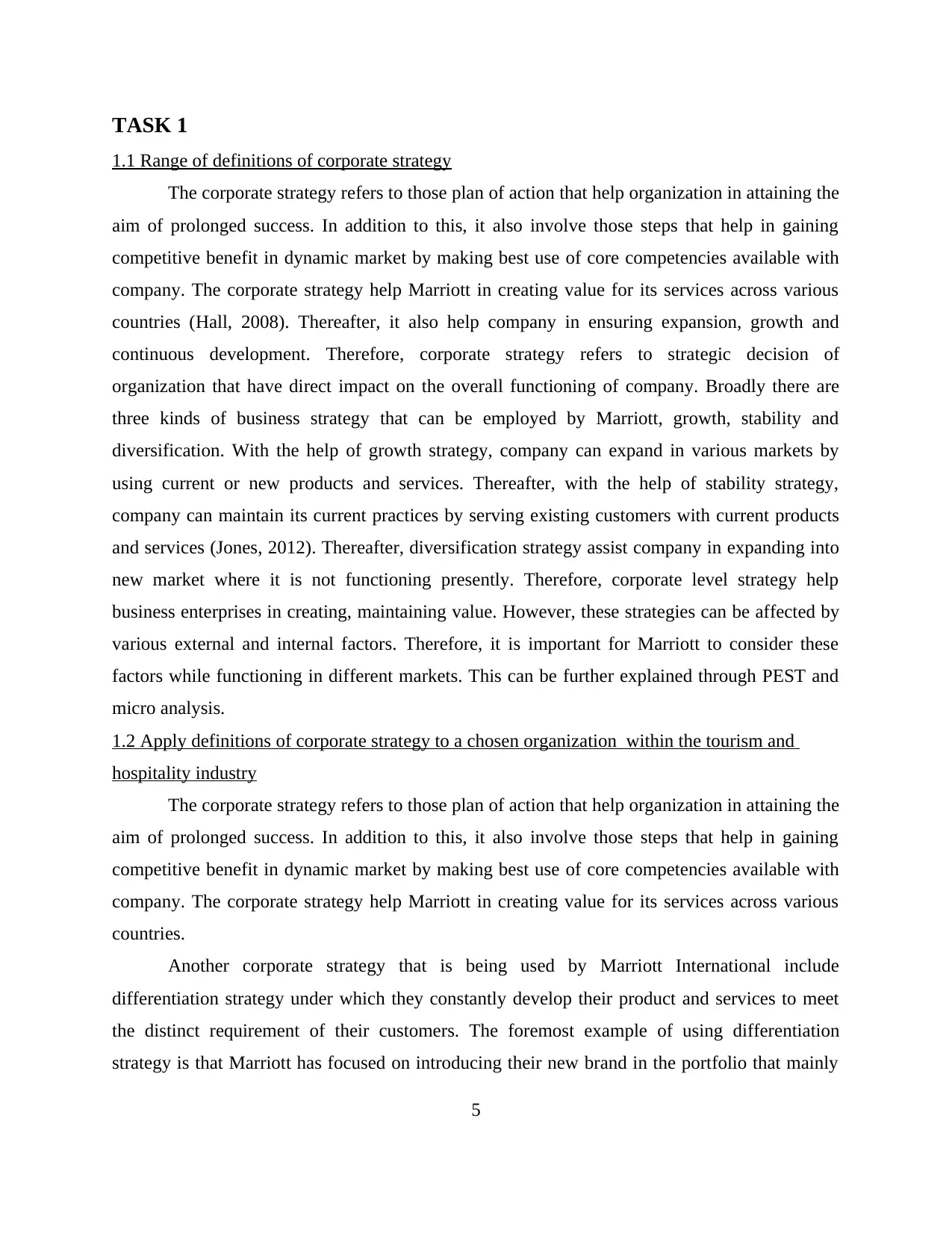
TASK 1
1.1 Range of definitions of corporate strategy
The corporate strategy refers to those plan of action that help organization in attaining the
aim of prolonged success. In addition to this, it also involve those steps that help in gaining
competitive benefit in dynamic market by making best use of core competencies available with
company. The corporate strategy help Marriott in creating value for its services across various
countries (Hall, 2008). Thereafter, it also help company in ensuring expansion, growth and
continuous development. Therefore, corporate strategy refers to strategic decision of
organization that have direct impact on the overall functioning of company. Broadly there are
three kinds of business strategy that can be employed by Marriott, growth, stability and
diversification. With the help of growth strategy, company can expand in various markets by
using current or new products and services. Thereafter, with the help of stability strategy,
company can maintain its current practices by serving existing customers with current products
and services (Jones, 2012). Thereafter, diversification strategy assist company in expanding into
new market where it is not functioning presently. Therefore, corporate level strategy help
business enterprises in creating, maintaining value. However, these strategies can be affected by
various external and internal factors. Therefore, it is important for Marriott to consider these
factors while functioning in different markets. This can be further explained through PEST and
micro analysis.
1.2 Apply definitions of corporate strategy to a chosen organization within the tourism and
hospitality industry
The corporate strategy refers to those plan of action that help organization in attaining the
aim of prolonged success. In addition to this, it also involve those steps that help in gaining
competitive benefit in dynamic market by making best use of core competencies available with
company. The corporate strategy help Marriott in creating value for its services across various
countries.
Another corporate strategy that is being used by Marriott International include
differentiation strategy under which they constantly develop their product and services to meet
the distinct requirement of their customers. The foremost example of using differentiation
strategy is that Marriott has focused on introducing their new brand in the portfolio that mainly
5
1.1 Range of definitions of corporate strategy
The corporate strategy refers to those plan of action that help organization in attaining the
aim of prolonged success. In addition to this, it also involve those steps that help in gaining
competitive benefit in dynamic market by making best use of core competencies available with
company. The corporate strategy help Marriott in creating value for its services across various
countries (Hall, 2008). Thereafter, it also help company in ensuring expansion, growth and
continuous development. Therefore, corporate strategy refers to strategic decision of
organization that have direct impact on the overall functioning of company. Broadly there are
three kinds of business strategy that can be employed by Marriott, growth, stability and
diversification. With the help of growth strategy, company can expand in various markets by
using current or new products and services. Thereafter, with the help of stability strategy,
company can maintain its current practices by serving existing customers with current products
and services (Jones, 2012). Thereafter, diversification strategy assist company in expanding into
new market where it is not functioning presently. Therefore, corporate level strategy help
business enterprises in creating, maintaining value. However, these strategies can be affected by
various external and internal factors. Therefore, it is important for Marriott to consider these
factors while functioning in different markets. This can be further explained through PEST and
micro analysis.
1.2 Apply definitions of corporate strategy to a chosen organization within the tourism and
hospitality industry
The corporate strategy refers to those plan of action that help organization in attaining the
aim of prolonged success. In addition to this, it also involve those steps that help in gaining
competitive benefit in dynamic market by making best use of core competencies available with
company. The corporate strategy help Marriott in creating value for its services across various
countries.
Another corporate strategy that is being used by Marriott International include
differentiation strategy under which they constantly develop their product and services to meet
the distinct requirement of their customers. The foremost example of using differentiation
strategy is that Marriott has focused on introducing their new brand in the portfolio that mainly
5
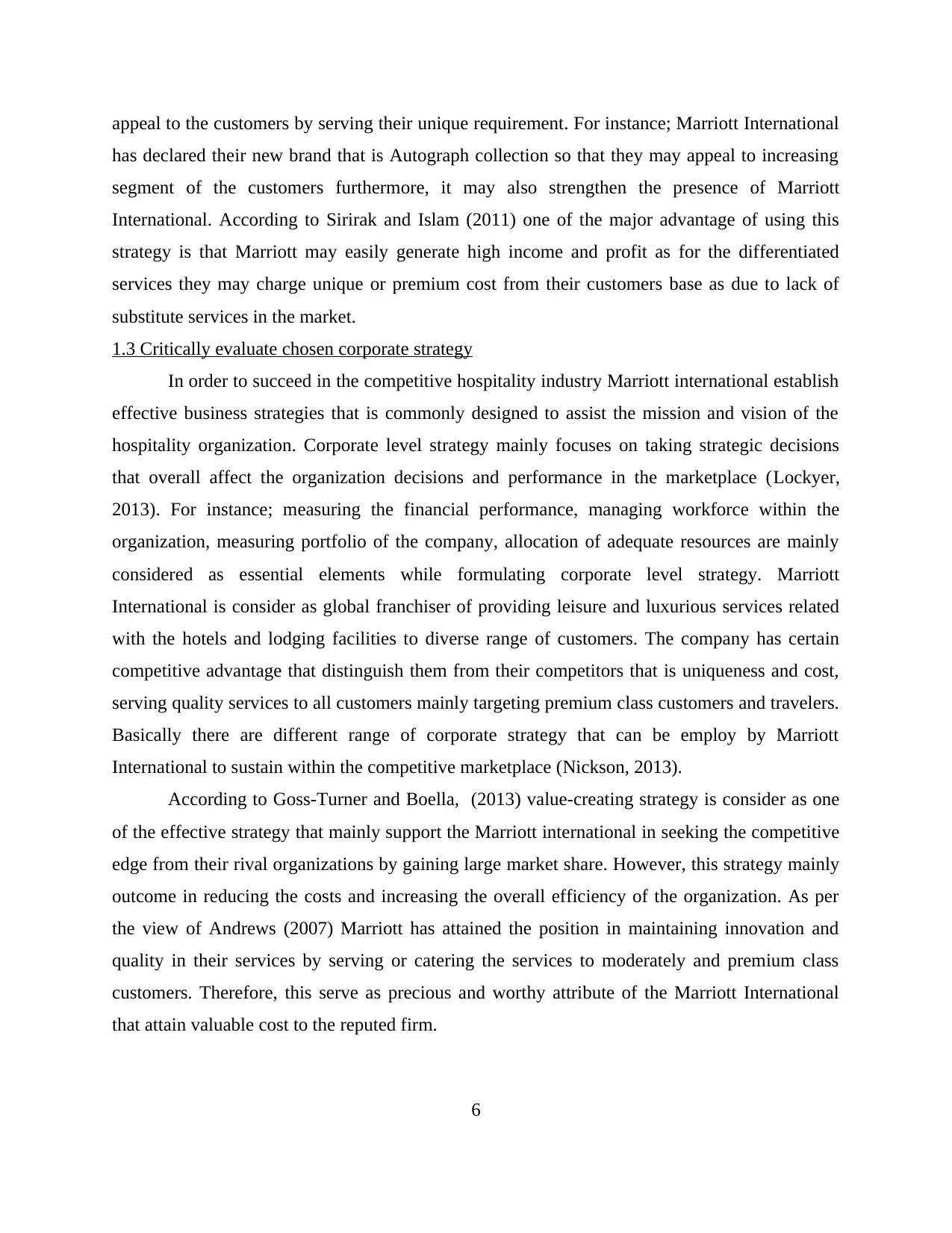
appeal to the customers by serving their unique requirement. For instance; Marriott International
has declared their new brand that is Autograph collection so that they may appeal to increasing
segment of the customers furthermore, it may also strengthen the presence of Marriott
International. According to Sirirak and Islam (2011) one of the major advantage of using this
strategy is that Marriott may easily generate high income and profit as for the differentiated
services they may charge unique or premium cost from their customers base as due to lack of
substitute services in the market.
1.3 Critically evaluate chosen corporate strategy
In order to succeed in the competitive hospitality industry Marriott international establish
effective business strategies that is commonly designed to assist the mission and vision of the
hospitality organization. Corporate level strategy mainly focuses on taking strategic decisions
that overall affect the organization decisions and performance in the marketplace (Lockyer,
2013). For instance; measuring the financial performance, managing workforce within the
organization, measuring portfolio of the company, allocation of adequate resources are mainly
considered as essential elements while formulating corporate level strategy. Marriott
International is consider as global franchiser of providing leisure and luxurious services related
with the hotels and lodging facilities to diverse range of customers. The company has certain
competitive advantage that distinguish them from their competitors that is uniqueness and cost,
serving quality services to all customers mainly targeting premium class customers and travelers.
Basically there are different range of corporate strategy that can be employ by Marriott
International to sustain within the competitive marketplace (Nickson, 2013).
According to Goss-Turner and Boella, (2013) value-creating strategy is consider as one
of the effective strategy that mainly support the Marriott international in seeking the competitive
edge from their rival organizations by gaining large market share. However, this strategy mainly
outcome in reducing the costs and increasing the overall efficiency of the organization. As per
the view of Andrews (2007) Marriott has attained the position in maintaining innovation and
quality in their services by serving or catering the services to moderately and premium class
customers. Therefore, this serve as precious and worthy attribute of the Marriott International
that attain valuable cost to the reputed firm.
6
has declared their new brand that is Autograph collection so that they may appeal to increasing
segment of the customers furthermore, it may also strengthen the presence of Marriott
International. According to Sirirak and Islam (2011) one of the major advantage of using this
strategy is that Marriott may easily generate high income and profit as for the differentiated
services they may charge unique or premium cost from their customers base as due to lack of
substitute services in the market.
1.3 Critically evaluate chosen corporate strategy
In order to succeed in the competitive hospitality industry Marriott international establish
effective business strategies that is commonly designed to assist the mission and vision of the
hospitality organization. Corporate level strategy mainly focuses on taking strategic decisions
that overall affect the organization decisions and performance in the marketplace (Lockyer,
2013). For instance; measuring the financial performance, managing workforce within the
organization, measuring portfolio of the company, allocation of adequate resources are mainly
considered as essential elements while formulating corporate level strategy. Marriott
International is consider as global franchiser of providing leisure and luxurious services related
with the hotels and lodging facilities to diverse range of customers. The company has certain
competitive advantage that distinguish them from their competitors that is uniqueness and cost,
serving quality services to all customers mainly targeting premium class customers and travelers.
Basically there are different range of corporate strategy that can be employ by Marriott
International to sustain within the competitive marketplace (Nickson, 2013).
According to Goss-Turner and Boella, (2013) value-creating strategy is consider as one
of the effective strategy that mainly support the Marriott international in seeking the competitive
edge from their rival organizations by gaining large market share. However, this strategy mainly
outcome in reducing the costs and increasing the overall efficiency of the organization. As per
the view of Andrews (2007) Marriott has attained the position in maintaining innovation and
quality in their services by serving or catering the services to moderately and premium class
customers. Therefore, this serve as precious and worthy attribute of the Marriott International
that attain valuable cost to the reputed firm.
6
⊘ This is a preview!⊘
Do you want full access?
Subscribe today to unlock all pages.

Trusted by 1+ million students worldwide
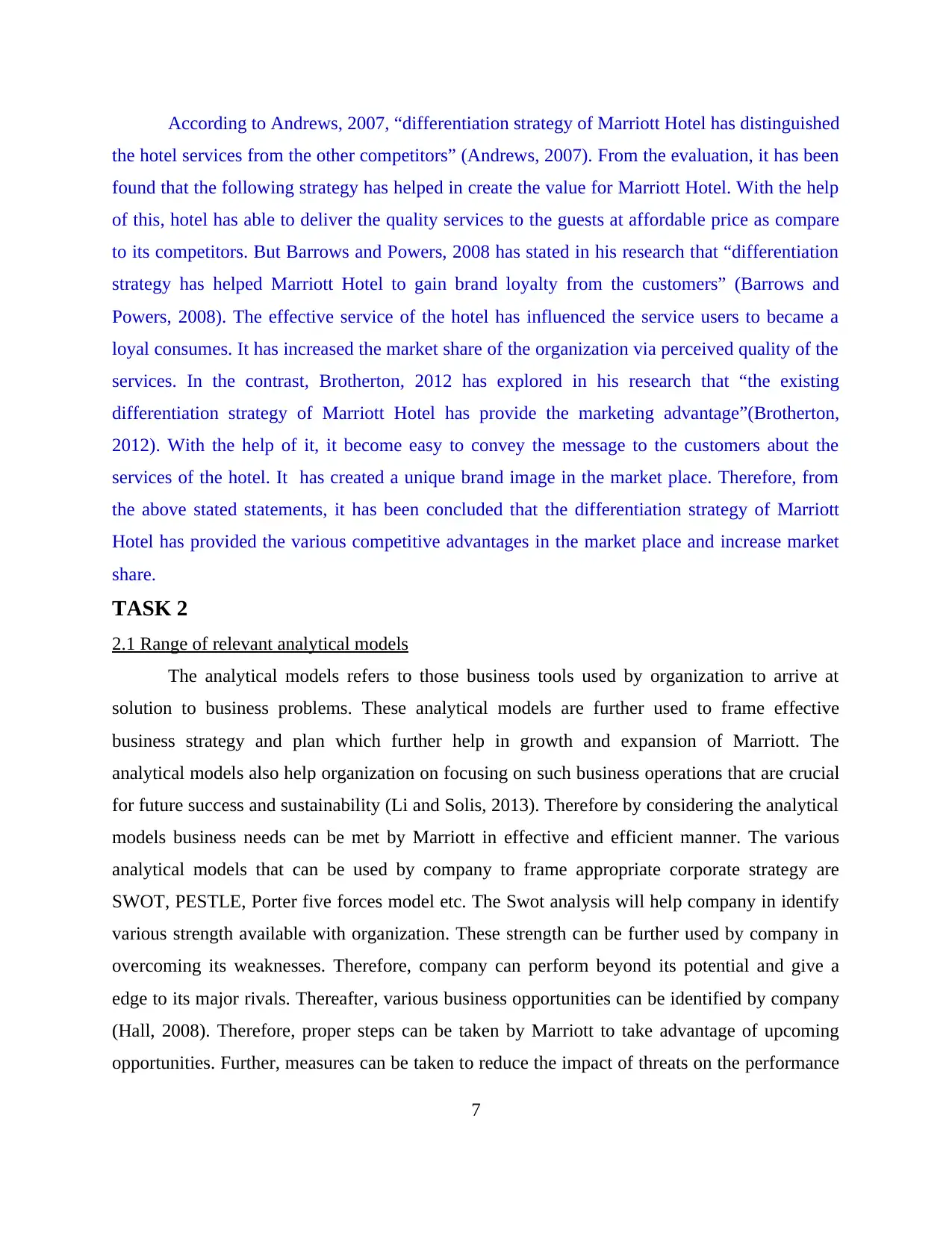
According to Andrews, 2007, “differentiation strategy of Marriott Hotel has distinguished
the hotel services from the other competitors” (Andrews, 2007). From the evaluation, it has been
found that the following strategy has helped in create the value for Marriott Hotel. With the help
of this, hotel has able to deliver the quality services to the guests at affordable price as compare
to its competitors. But Barrows and Powers, 2008 has stated in his research that “differentiation
strategy has helped Marriott Hotel to gain brand loyalty from the customers” (Barrows and
Powers, 2008). The effective service of the hotel has influenced the service users to became a
loyal consumes. It has increased the market share of the organization via perceived quality of the
services. In the contrast, Brotherton, 2012 has explored in his research that “the existing
differentiation strategy of Marriott Hotel has provide the marketing advantage”(Brotherton,
2012). With the help of it, it become easy to convey the message to the customers about the
services of the hotel. It has created a unique brand image in the market place. Therefore, from
the above stated statements, it has been concluded that the differentiation strategy of Marriott
Hotel has provided the various competitive advantages in the market place and increase market
share.
TASK 2
2.1 Range of relevant analytical models
The analytical models refers to those business tools used by organization to arrive at
solution to business problems. These analytical models are further used to frame effective
business strategy and plan which further help in growth and expansion of Marriott. The
analytical models also help organization on focusing on such business operations that are crucial
for future success and sustainability (Li and Solis, 2013). Therefore by considering the analytical
models business needs can be met by Marriott in effective and efficient manner. The various
analytical models that can be used by company to frame appropriate corporate strategy are
SWOT, PESTLE, Porter five forces model etc. The Swot analysis will help company in identify
various strength available with organization. These strength can be further used by company in
overcoming its weaknesses. Therefore, company can perform beyond its potential and give a
edge to its major rivals. Thereafter, various business opportunities can be identified by company
(Hall, 2008). Therefore, proper steps can be taken by Marriott to take advantage of upcoming
opportunities. Further, measures can be taken to reduce the impact of threats on the performance
7
the hotel services from the other competitors” (Andrews, 2007). From the evaluation, it has been
found that the following strategy has helped in create the value for Marriott Hotel. With the help
of this, hotel has able to deliver the quality services to the guests at affordable price as compare
to its competitors. But Barrows and Powers, 2008 has stated in his research that “differentiation
strategy has helped Marriott Hotel to gain brand loyalty from the customers” (Barrows and
Powers, 2008). The effective service of the hotel has influenced the service users to became a
loyal consumes. It has increased the market share of the organization via perceived quality of the
services. In the contrast, Brotherton, 2012 has explored in his research that “the existing
differentiation strategy of Marriott Hotel has provide the marketing advantage”(Brotherton,
2012). With the help of it, it become easy to convey the message to the customers about the
services of the hotel. It has created a unique brand image in the market place. Therefore, from
the above stated statements, it has been concluded that the differentiation strategy of Marriott
Hotel has provided the various competitive advantages in the market place and increase market
share.
TASK 2
2.1 Range of relevant analytical models
The analytical models refers to those business tools used by organization to arrive at
solution to business problems. These analytical models are further used to frame effective
business strategy and plan which further help in growth and expansion of Marriott. The
analytical models also help organization on focusing on such business operations that are crucial
for future success and sustainability (Li and Solis, 2013). Therefore by considering the analytical
models business needs can be met by Marriott in effective and efficient manner. The various
analytical models that can be used by company to frame appropriate corporate strategy are
SWOT, PESTLE, Porter five forces model etc. The Swot analysis will help company in identify
various strength available with organization. These strength can be further used by company in
overcoming its weaknesses. Therefore, company can perform beyond its potential and give a
edge to its major rivals. Thereafter, various business opportunities can be identified by company
(Hall, 2008). Therefore, proper steps can be taken by Marriott to take advantage of upcoming
opportunities. Further, measures can be taken to reduce the impact of threats on the performance
7
Paraphrase This Document
Need a fresh take? Get an instant paraphrase of this document with our AI Paraphraser
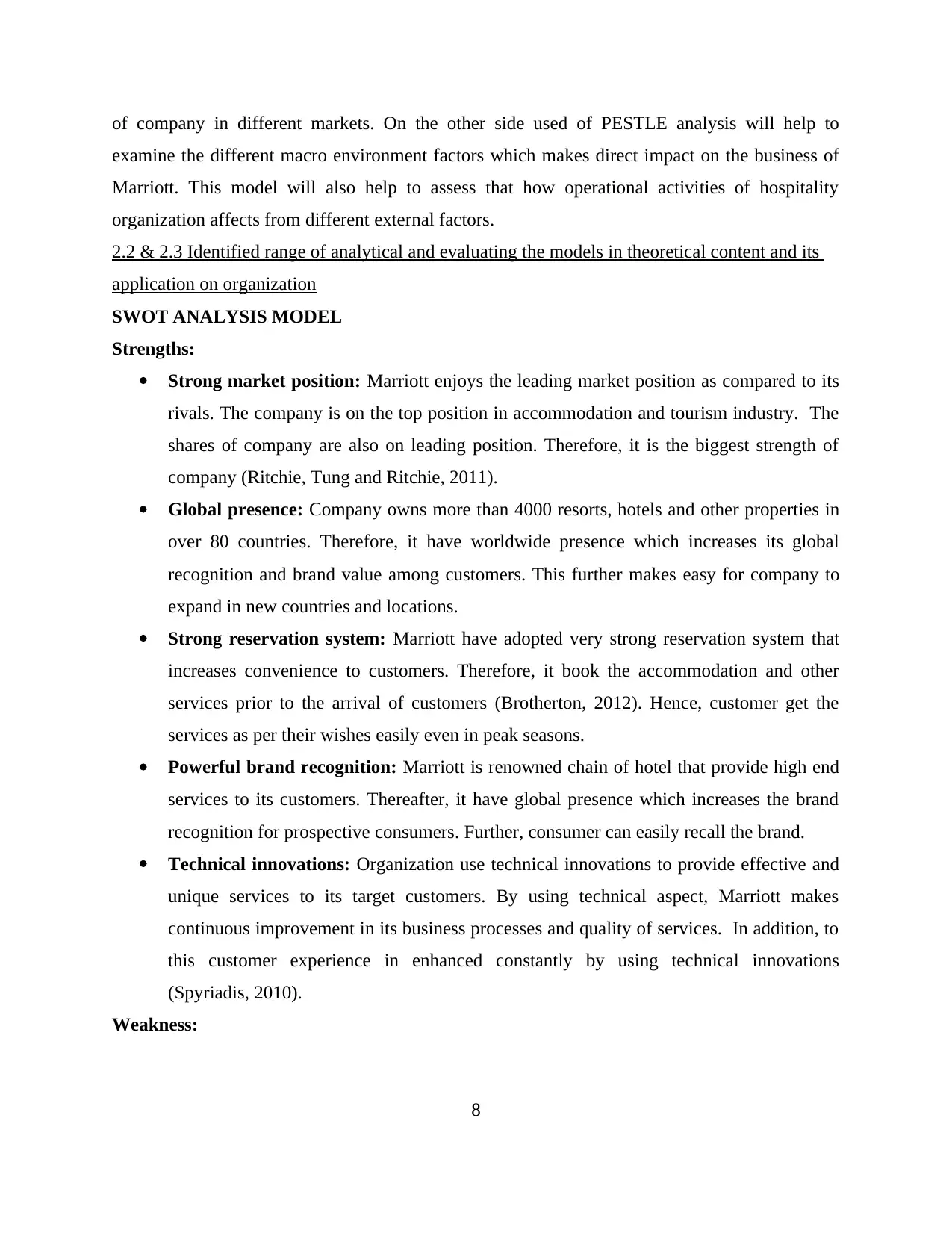
of company in different markets. On the other side used of PESTLE analysis will help to
examine the different macro environment factors which makes direct impact on the business of
Marriott. This model will also help to assess that how operational activities of hospitality
organization affects from different external factors.
2.2 & 2.3 Identified range of analytical and evaluating the models in theoretical content and its
application on organization
SWOT ANALYSIS MODEL
Strengths:
Strong market position: Marriott enjoys the leading market position as compared to its
rivals. The company is on the top position in accommodation and tourism industry. The
shares of company are also on leading position. Therefore, it is the biggest strength of
company (Ritchie, Tung and Ritchie, 2011).
Global presence: Company owns more than 4000 resorts, hotels and other properties in
over 80 countries. Therefore, it have worldwide presence which increases its global
recognition and brand value among customers. This further makes easy for company to
expand in new countries and locations.
Strong reservation system: Marriott have adopted very strong reservation system that
increases convenience to customers. Therefore, it book the accommodation and other
services prior to the arrival of customers (Brotherton, 2012). Hence, customer get the
services as per their wishes easily even in peak seasons.
Powerful brand recognition: Marriott is renowned chain of hotel that provide high end
services to its customers. Thereafter, it have global presence which increases the brand
recognition for prospective consumers. Further, consumer can easily recall the brand.
Technical innovations: Organization use technical innovations to provide effective and
unique services to its target customers. By using technical aspect, Marriott makes
continuous improvement in its business processes and quality of services. In addition, to
this customer experience in enhanced constantly by using technical innovations
(Spyriadis, 2010).
Weakness:
8
examine the different macro environment factors which makes direct impact on the business of
Marriott. This model will also help to assess that how operational activities of hospitality
organization affects from different external factors.
2.2 & 2.3 Identified range of analytical and evaluating the models in theoretical content and its
application on organization
SWOT ANALYSIS MODEL
Strengths:
Strong market position: Marriott enjoys the leading market position as compared to its
rivals. The company is on the top position in accommodation and tourism industry. The
shares of company are also on leading position. Therefore, it is the biggest strength of
company (Ritchie, Tung and Ritchie, 2011).
Global presence: Company owns more than 4000 resorts, hotels and other properties in
over 80 countries. Therefore, it have worldwide presence which increases its global
recognition and brand value among customers. This further makes easy for company to
expand in new countries and locations.
Strong reservation system: Marriott have adopted very strong reservation system that
increases convenience to customers. Therefore, it book the accommodation and other
services prior to the arrival of customers (Brotherton, 2012). Hence, customer get the
services as per their wishes easily even in peak seasons.
Powerful brand recognition: Marriott is renowned chain of hotel that provide high end
services to its customers. Thereafter, it have global presence which increases the brand
recognition for prospective consumers. Further, consumer can easily recall the brand.
Technical innovations: Organization use technical innovations to provide effective and
unique services to its target customers. By using technical aspect, Marriott makes
continuous improvement in its business processes and quality of services. In addition, to
this customer experience in enhanced constantly by using technical innovations
(Spyriadis, 2010).
Weakness:
8
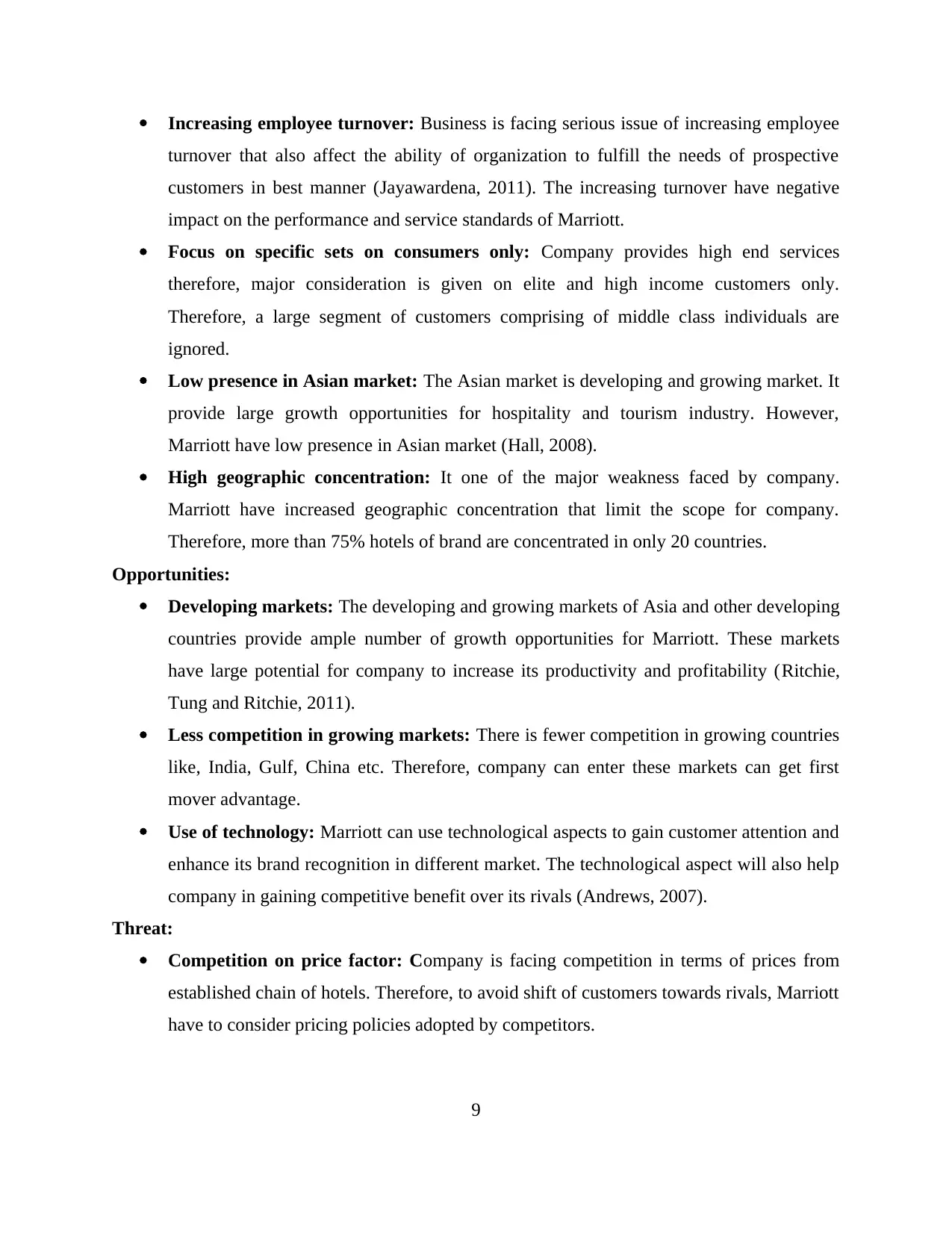
Increasing employee turnover: Business is facing serious issue of increasing employee
turnover that also affect the ability of organization to fulfill the needs of prospective
customers in best manner (Jayawardena, 2011). The increasing turnover have negative
impact on the performance and service standards of Marriott.
Focus on specific sets on consumers only: Company provides high end services
therefore, major consideration is given on elite and high income customers only.
Therefore, a large segment of customers comprising of middle class individuals are
ignored.
Low presence in Asian market: The Asian market is developing and growing market. It
provide large growth opportunities for hospitality and tourism industry. However,
Marriott have low presence in Asian market (Hall, 2008).
High geographic concentration: It one of the major weakness faced by company.
Marriott have increased geographic concentration that limit the scope for company.
Therefore, more than 75% hotels of brand are concentrated in only 20 countries.
Opportunities:
Developing markets: The developing and growing markets of Asia and other developing
countries provide ample number of growth opportunities for Marriott. These markets
have large potential for company to increase its productivity and profitability (Ritchie,
Tung and Ritchie, 2011).
Less competition in growing markets: There is fewer competition in growing countries
like, India, Gulf, China etc. Therefore, company can enter these markets can get first
mover advantage.
Use of technology: Marriott can use technological aspects to gain customer attention and
enhance its brand recognition in different market. The technological aspect will also help
company in gaining competitive benefit over its rivals (Andrews, 2007).
Threat:
Competition on price factor: Company is facing competition in terms of prices from
established chain of hotels. Therefore, to avoid shift of customers towards rivals, Marriott
have to consider pricing policies adopted by competitors.
9
turnover that also affect the ability of organization to fulfill the needs of prospective
customers in best manner (Jayawardena, 2011). The increasing turnover have negative
impact on the performance and service standards of Marriott.
Focus on specific sets on consumers only: Company provides high end services
therefore, major consideration is given on elite and high income customers only.
Therefore, a large segment of customers comprising of middle class individuals are
ignored.
Low presence in Asian market: The Asian market is developing and growing market. It
provide large growth opportunities for hospitality and tourism industry. However,
Marriott have low presence in Asian market (Hall, 2008).
High geographic concentration: It one of the major weakness faced by company.
Marriott have increased geographic concentration that limit the scope for company.
Therefore, more than 75% hotels of brand are concentrated in only 20 countries.
Opportunities:
Developing markets: The developing and growing markets of Asia and other developing
countries provide ample number of growth opportunities for Marriott. These markets
have large potential for company to increase its productivity and profitability (Ritchie,
Tung and Ritchie, 2011).
Less competition in growing markets: There is fewer competition in growing countries
like, India, Gulf, China etc. Therefore, company can enter these markets can get first
mover advantage.
Use of technology: Marriott can use technological aspects to gain customer attention and
enhance its brand recognition in different market. The technological aspect will also help
company in gaining competitive benefit over its rivals (Andrews, 2007).
Threat:
Competition on price factor: Company is facing competition in terms of prices from
established chain of hotels. Therefore, to avoid shift of customers towards rivals, Marriott
have to consider pricing policies adopted by competitors.
9
⊘ This is a preview!⊘
Do you want full access?
Subscribe today to unlock all pages.

Trusted by 1+ million students worldwide
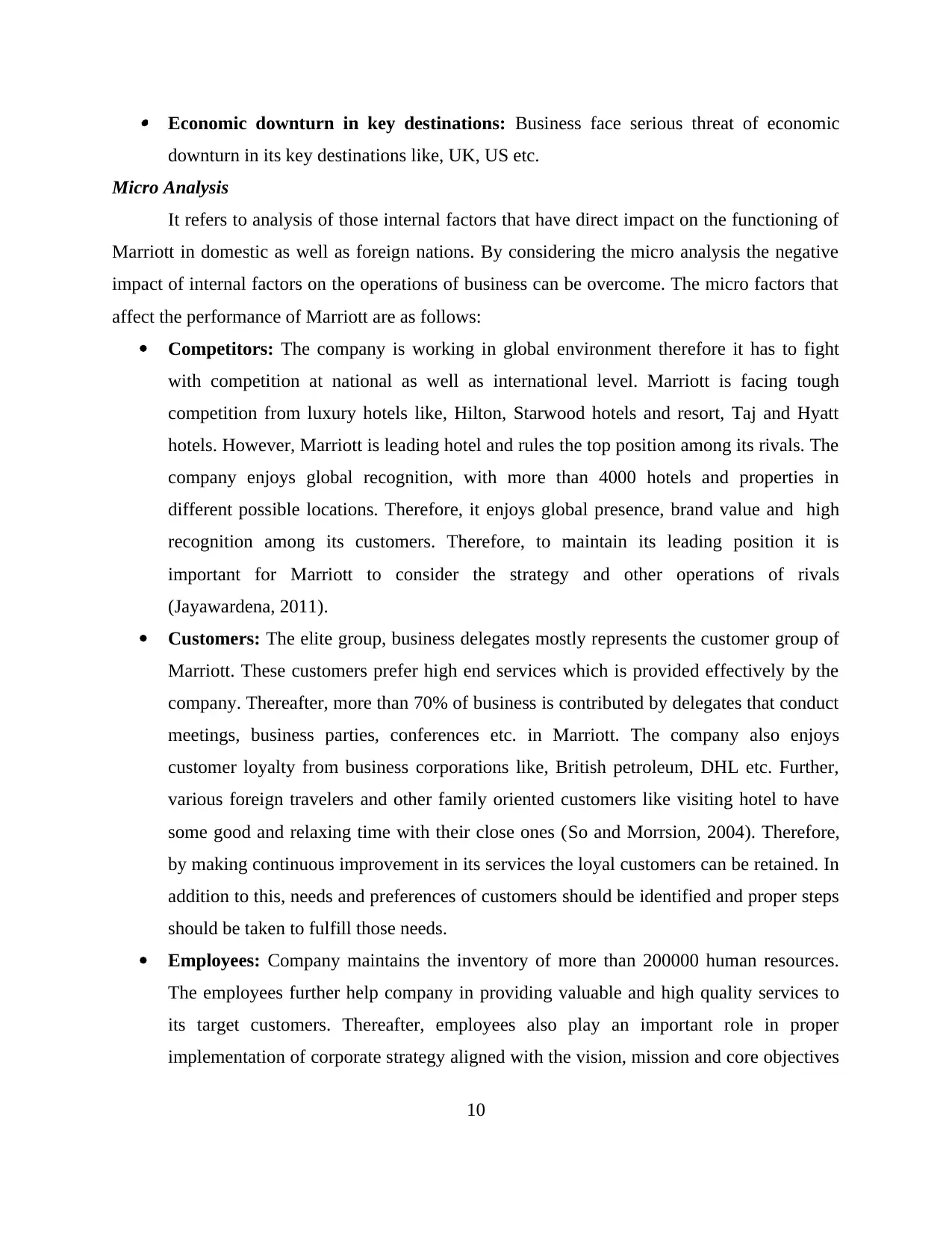
Economic downturn in key destinations: Business face serious threat of economic
downturn in its key destinations like, UK, US etc.
Micro Analysis
It refers to analysis of those internal factors that have direct impact on the functioning of
Marriott in domestic as well as foreign nations. By considering the micro analysis the negative
impact of internal factors on the operations of business can be overcome. The micro factors that
affect the performance of Marriott are as follows:
Competitors: The company is working in global environment therefore it has to fight
with competition at national as well as international level. Marriott is facing tough
competition from luxury hotels like, Hilton, Starwood hotels and resort, Taj and Hyatt
hotels. However, Marriott is leading hotel and rules the top position among its rivals. The
company enjoys global recognition, with more than 4000 hotels and properties in
different possible locations. Therefore, it enjoys global presence, brand value and high
recognition among its customers. Therefore, to maintain its leading position it is
important for Marriott to consider the strategy and other operations of rivals
(Jayawardena, 2011).
Customers: The elite group, business delegates mostly represents the customer group of
Marriott. These customers prefer high end services which is provided effectively by the
company. Thereafter, more than 70% of business is contributed by delegates that conduct
meetings, business parties, conferences etc. in Marriott. The company also enjoys
customer loyalty from business corporations like, British petroleum, DHL etc. Further,
various foreign travelers and other family oriented customers like visiting hotel to have
some good and relaxing time with their close ones (So and Morrsion, 2004). Therefore,
by making continuous improvement in its services the loyal customers can be retained. In
addition to this, needs and preferences of customers should be identified and proper steps
should be taken to fulfill those needs.
Employees: Company maintains the inventory of more than 200000 human resources.
The employees further help company in providing valuable and high quality services to
its target customers. Thereafter, employees also play an important role in proper
implementation of corporate strategy aligned with the vision, mission and core objectives
10
downturn in its key destinations like, UK, US etc.
Micro Analysis
It refers to analysis of those internal factors that have direct impact on the functioning of
Marriott in domestic as well as foreign nations. By considering the micro analysis the negative
impact of internal factors on the operations of business can be overcome. The micro factors that
affect the performance of Marriott are as follows:
Competitors: The company is working in global environment therefore it has to fight
with competition at national as well as international level. Marriott is facing tough
competition from luxury hotels like, Hilton, Starwood hotels and resort, Taj and Hyatt
hotels. However, Marriott is leading hotel and rules the top position among its rivals. The
company enjoys global recognition, with more than 4000 hotels and properties in
different possible locations. Therefore, it enjoys global presence, brand value and high
recognition among its customers. Therefore, to maintain its leading position it is
important for Marriott to consider the strategy and other operations of rivals
(Jayawardena, 2011).
Customers: The elite group, business delegates mostly represents the customer group of
Marriott. These customers prefer high end services which is provided effectively by the
company. Thereafter, more than 70% of business is contributed by delegates that conduct
meetings, business parties, conferences etc. in Marriott. The company also enjoys
customer loyalty from business corporations like, British petroleum, DHL etc. Further,
various foreign travelers and other family oriented customers like visiting hotel to have
some good and relaxing time with their close ones (So and Morrsion, 2004). Therefore,
by making continuous improvement in its services the loyal customers can be retained. In
addition to this, needs and preferences of customers should be identified and proper steps
should be taken to fulfill those needs.
Employees: Company maintains the inventory of more than 200000 human resources.
The employees further help company in providing valuable and high quality services to
its target customers. Thereafter, employees also play an important role in proper
implementation of corporate strategy aligned with the vision, mission and core objectives
10
Paraphrase This Document
Need a fresh take? Get an instant paraphrase of this document with our AI Paraphraser
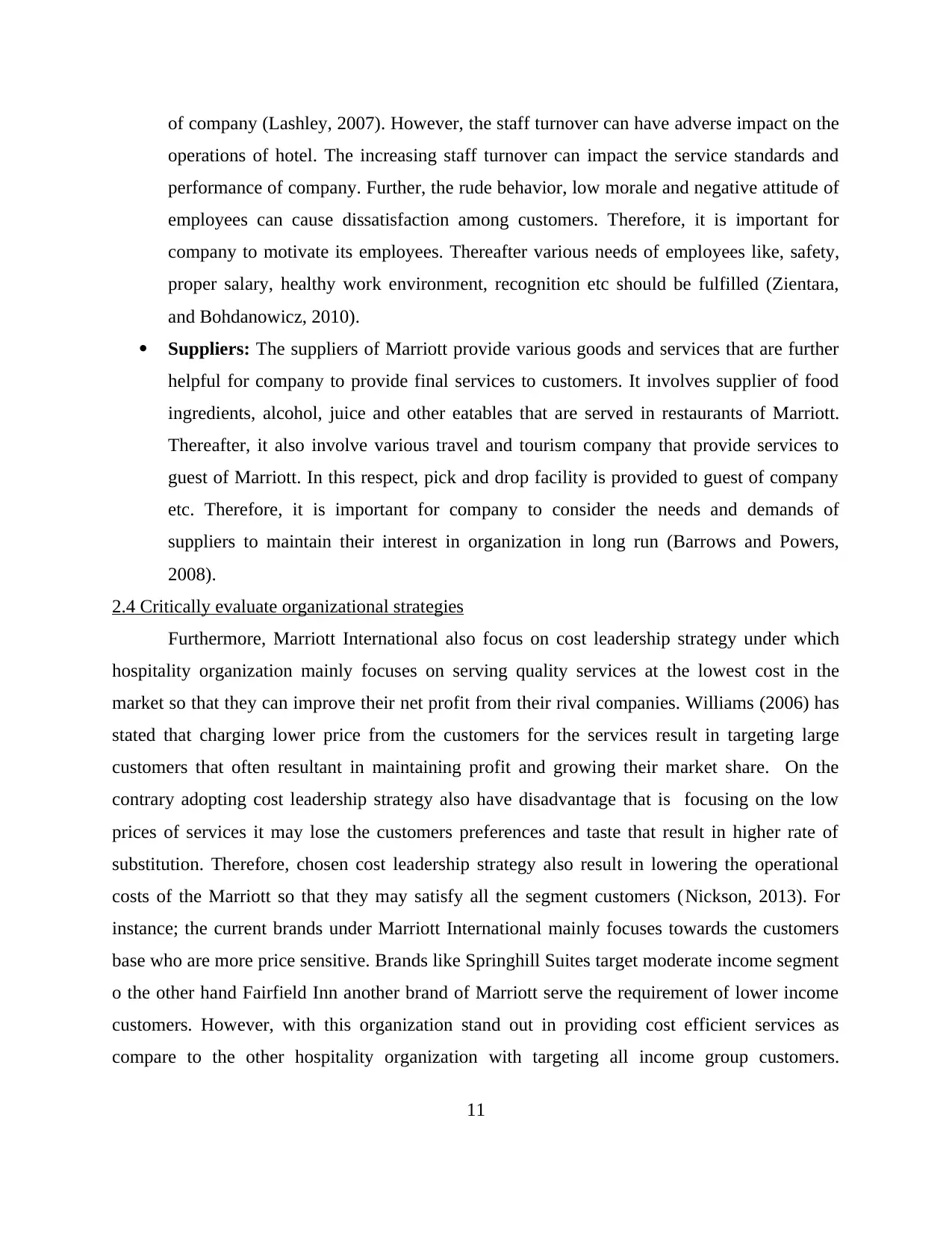
of company (Lashley, 2007). However, the staff turnover can have adverse impact on the
operations of hotel. The increasing staff turnover can impact the service standards and
performance of company. Further, the rude behavior, low morale and negative attitude of
employees can cause dissatisfaction among customers. Therefore, it is important for
company to motivate its employees. Thereafter various needs of employees like, safety,
proper salary, healthy work environment, recognition etc should be fulfilled (Zientara,
and Bohdanowicz, 2010).
Suppliers: The suppliers of Marriott provide various goods and services that are further
helpful for company to provide final services to customers. It involves supplier of food
ingredients, alcohol, juice and other eatables that are served in restaurants of Marriott.
Thereafter, it also involve various travel and tourism company that provide services to
guest of Marriott. In this respect, pick and drop facility is provided to guest of company
etc. Therefore, it is important for company to consider the needs and demands of
suppliers to maintain their interest in organization in long run (Barrows and Powers,
2008).
2.4 Critically evaluate organizational strategies
Furthermore, Marriott International also focus on cost leadership strategy under which
hospitality organization mainly focuses on serving quality services at the lowest cost in the
market so that they can improve their net profit from their rival companies. Williams (2006) has
stated that charging lower price from the customers for the services result in targeting large
customers that often resultant in maintaining profit and growing their market share. On the
contrary adopting cost leadership strategy also have disadvantage that is focusing on the low
prices of services it may lose the customers preferences and taste that result in higher rate of
substitution. Therefore, chosen cost leadership strategy also result in lowering the operational
costs of the Marriott so that they may satisfy all the segment customers (Nickson, 2013). For
instance; the current brands under Marriott International mainly focuses towards the customers
base who are more price sensitive. Brands like Springhill Suites target moderate income segment
o the other hand Fairfield Inn another brand of Marriott serve the requirement of lower income
customers. However, with this organization stand out in providing cost efficient services as
compare to the other hospitality organization with targeting all income group customers.
11
operations of hotel. The increasing staff turnover can impact the service standards and
performance of company. Further, the rude behavior, low morale and negative attitude of
employees can cause dissatisfaction among customers. Therefore, it is important for
company to motivate its employees. Thereafter various needs of employees like, safety,
proper salary, healthy work environment, recognition etc should be fulfilled (Zientara,
and Bohdanowicz, 2010).
Suppliers: The suppliers of Marriott provide various goods and services that are further
helpful for company to provide final services to customers. It involves supplier of food
ingredients, alcohol, juice and other eatables that are served in restaurants of Marriott.
Thereafter, it also involve various travel and tourism company that provide services to
guest of Marriott. In this respect, pick and drop facility is provided to guest of company
etc. Therefore, it is important for company to consider the needs and demands of
suppliers to maintain their interest in organization in long run (Barrows and Powers,
2008).
2.4 Critically evaluate organizational strategies
Furthermore, Marriott International also focus on cost leadership strategy under which
hospitality organization mainly focuses on serving quality services at the lowest cost in the
market so that they can improve their net profit from their rival companies. Williams (2006) has
stated that charging lower price from the customers for the services result in targeting large
customers that often resultant in maintaining profit and growing their market share. On the
contrary adopting cost leadership strategy also have disadvantage that is focusing on the low
prices of services it may lose the customers preferences and taste that result in higher rate of
substitution. Therefore, chosen cost leadership strategy also result in lowering the operational
costs of the Marriott so that they may satisfy all the segment customers (Nickson, 2013). For
instance; the current brands under Marriott International mainly focuses towards the customers
base who are more price sensitive. Brands like Springhill Suites target moderate income segment
o the other hand Fairfield Inn another brand of Marriott serve the requirement of lower income
customers. However, with this organization stand out in providing cost efficient services as
compare to the other hospitality organization with targeting all income group customers.
11
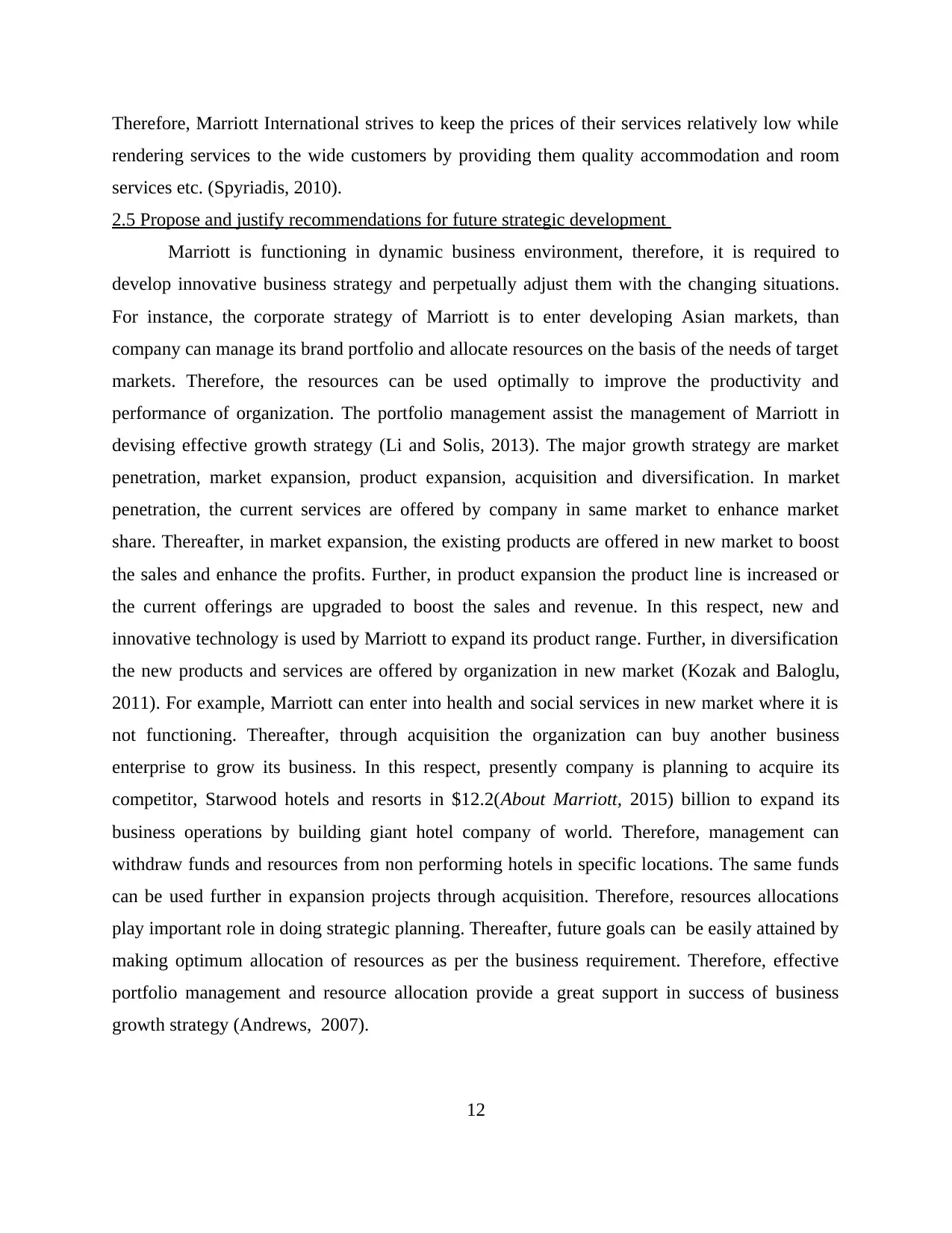
Therefore, Marriott International strives to keep the prices of their services relatively low while
rendering services to the wide customers by providing them quality accommodation and room
services etc. (Spyriadis, 2010).
2.5 Propose and justify recommendations for future strategic development
Marriott is functioning in dynamic business environment, therefore, it is required to
develop innovative business strategy and perpetually adjust them with the changing situations.
For instance, the corporate strategy of Marriott is to enter developing Asian markets, than
company can manage its brand portfolio and allocate resources on the basis of the needs of target
markets. Therefore, the resources can be used optimally to improve the productivity and
performance of organization. The portfolio management assist the management of Marriott in
devising effective growth strategy (Li and Solis, 2013). The major growth strategy are market
penetration, market expansion, product expansion, acquisition and diversification. In market
penetration, the current services are offered by company in same market to enhance market
share. Thereafter, in market expansion, the existing products are offered in new market to boost
the sales and enhance the profits. Further, in product expansion the product line is increased or
the current offerings are upgraded to boost the sales and revenue. In this respect, new and
innovative technology is used by Marriott to expand its product range. Further, in diversification
the new products and services are offered by organization in new market (Kozak and Baloglu,
2011). For example, Marriott can enter into health and social services in new market where it is
not functioning. Thereafter, through acquisition the organization can buy another business
enterprise to grow its business. In this respect, presently company is planning to acquire its
competitor, Starwood hotels and resorts in $12.2(About Marriott, 2015) billion to expand its
business operations by building giant hotel company of world. Therefore, management can
withdraw funds and resources from non performing hotels in specific locations. The same funds
can be used further in expansion projects through acquisition. Therefore, resources allocations
play important role in doing strategic planning. Thereafter, future goals can be easily attained by
making optimum allocation of resources as per the business requirement. Therefore, effective
portfolio management and resource allocation provide a great support in success of business
growth strategy (Andrews, 2007).
12
rendering services to the wide customers by providing them quality accommodation and room
services etc. (Spyriadis, 2010).
2.5 Propose and justify recommendations for future strategic development
Marriott is functioning in dynamic business environment, therefore, it is required to
develop innovative business strategy and perpetually adjust them with the changing situations.
For instance, the corporate strategy of Marriott is to enter developing Asian markets, than
company can manage its brand portfolio and allocate resources on the basis of the needs of target
markets. Therefore, the resources can be used optimally to improve the productivity and
performance of organization. The portfolio management assist the management of Marriott in
devising effective growth strategy (Li and Solis, 2013). The major growth strategy are market
penetration, market expansion, product expansion, acquisition and diversification. In market
penetration, the current services are offered by company in same market to enhance market
share. Thereafter, in market expansion, the existing products are offered in new market to boost
the sales and enhance the profits. Further, in product expansion the product line is increased or
the current offerings are upgraded to boost the sales and revenue. In this respect, new and
innovative technology is used by Marriott to expand its product range. Further, in diversification
the new products and services are offered by organization in new market (Kozak and Baloglu,
2011). For example, Marriott can enter into health and social services in new market where it is
not functioning. Thereafter, through acquisition the organization can buy another business
enterprise to grow its business. In this respect, presently company is planning to acquire its
competitor, Starwood hotels and resorts in $12.2(About Marriott, 2015) billion to expand its
business operations by building giant hotel company of world. Therefore, management can
withdraw funds and resources from non performing hotels in specific locations. The same funds
can be used further in expansion projects through acquisition. Therefore, resources allocations
play important role in doing strategic planning. Thereafter, future goals can be easily attained by
making optimum allocation of resources as per the business requirement. Therefore, effective
portfolio management and resource allocation provide a great support in success of business
growth strategy (Andrews, 2007).
12
⊘ This is a preview!⊘
Do you want full access?
Subscribe today to unlock all pages.

Trusted by 1+ million students worldwide
1 out of 29
Related Documents
Your All-in-One AI-Powered Toolkit for Academic Success.
+13062052269
info@desklib.com
Available 24*7 on WhatsApp / Email
![[object Object]](/_next/static/media/star-bottom.7253800d.svg)
Unlock your academic potential
Copyright © 2020–2025 A2Z Services. All Rights Reserved. Developed and managed by ZUCOL.





